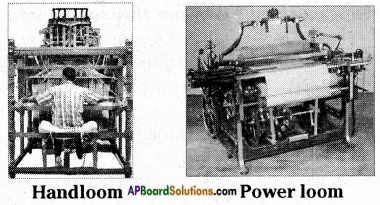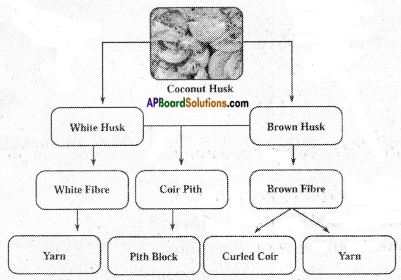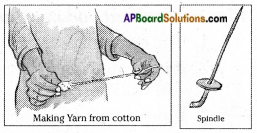AP State Syllabus AP Board 6th Class Science Important Questions Chapter 8 How Fabrics are Made
AP State Syllabus 6th Class Science Important Questions 8th Lesson How Fabrics are Made
6th Class Science 8th Lesson How Fabrics are Made 2 Mark Important Questions and Answers
Question 1.
What are natural fibres? Give examples?
Answer:
The fibres which are deriving from plants and animals are called natural fibres.
Ex: cotton, wool, silk, jute, coir, etc.
Question 2.
What are Artificial fibres? Give examples?
Answer:
The fibres which are deriving from chemicals are artificial fibres or synthetic fibres. Ex : – Polyester, polythene, Nylon, Rayon, etc.
Question 3.
What is fibre?
Answer:
Small strand-like structures are called fibres.
Question 4.
What is weaving?
Answer:
Making fabric from yarn is called weaving.
![]()
Question 5.
How can you remove wrinkles from our dress?
Answer:
By ironing, we can remove wrinkles from our dress.
Question 6.
How are clothes useful to us?
Answer:
1) The clothes are used as a shield to protect ourselves from different weather conditions.
2) Along with protection, clothes can also be a symbol of beauty and status.
Question 7.
Which fabric is used in making banners and book bindings?
Answer:
Calico is a type of fabric used in making banners and book bindings.
Question 8.
Which fibre is known as golden fibres?
Answer:
Jute.
Question 9.
Which state is the highest produces of Jute in India?
Answer:
West Bengal.
Question 10.
Why should we use cloth bags instead of polythene bags?
Answer:
To protect our environment we should use cloth bags instead of polythene bags.
Question 11.
Which type of fabrics dries in a short time?
Answer:
Artificial fabrics dry in a short time.
Question 12.
Why seeds are removing from cotton balls?
Answer:
Cotton seeds are removing from cotton balls to make an even and uniform fabric.
Question 13.
Why we spin the fibres in order to make yarn?
Answer:
Fibres are very thin and weak we twist them together to make them strong thick and long.
Question 14.
Which material is used for making gunny bags and why?
Answer:
Jute fibres are used for making gunny bags. Because they are strong and can hold heavy loads.
Question 15.
Name the two types of looms?
Answer:
Handlooms and power loom.
Question 16.
Name the two simple devices used for spinning?
Answer:
Spindle (Takli) and Charaka.
![]()
Question 17.
Name the person who made the Charaka popular during the Independence movement?
Answer:
Mahatma Gandhi.
Question 18.
Where is the coconut industry well developed in India?
Answer:
The coconut industry is mainly well developed in the states of Kerala* Tamilnadu, Karnataka, Andhra Pradesh and Odisha.
Question 19.
Which area is famous for Kalamkari Textiles?
Answer:
Machilipatnam and Pedana are famous for Kalamkari textiles.
Question 20.
Which city is famous for the carpet industry?
Answer:
Machilipatnam.
6th Class Science 8th Lesson How Fabrics are Made 4 Mark Important Questions and Answers
Question 1.
While purchasing your dress what doubts would you want to clarify from the shopkeepers?
Answer:
- What type of washing does it need?
- Will it absorb the sweat of the body?
- Does the cloth provide free airflow to the body?
- What is the durability of cloth?
Question 2.
How can different fabrics be used?
Answer:
- Our purpose and the priority of fabric together determine which type of fabric to be used.
- Coarse fabrics can be used for mopping and making gunny bags but not for making clothes.
- Some fabrics have to be considered for choosing curtain fabrics.
- The calico fabric used to make banners and bookbinding.
Question 3.
Where is the handloom industry well developed in our state?
Answer:
- The handloom industry is very well developed in our state.
- Places like Venkatagiri, Narayanapeta, Dharmavaram, Mangalagiri and Kothakota are famous for handloom industries.
- Pedana and Machilipatnam are famous for kalamkari.
- Machilipatnam is also famous for the carpet industry.
Question 4.
Where is child labour working? Why are they forced into labour? How can you eradicate child labour?
Answer:
- In agricultural works, where cotton is widely grown, their child labourers are working.
- To pick up maturing cotton bolls from cotton plants, children work in field as child labourers.
- Some parents to get additional income through their children are putting them as child labourers.
- Some organizations are working against child labourers and sending them back to schools.
![]()
Question 5.
What are the uses of coir?
Answer:
- The coconut coir industry is one of the rural industry in India.
- The coir is still used for agricultural and domestic purposes, and controlling landslide or soil erosion.
- Brown coir is used in brushes, doormats, mattresses and for making sacks.
Question 6.
What are different clothes used in ancient times by human beings?
Answer:
- Human beings in ancient times use leaves and skins of animals as clothes.
- Clothes were also made from metal Warriors used to wear a metal jacket during wars.
- You can see clothes like these in historical museums are in television shows.
Question 7.
What are the uses of the gunny bags?
Answer:
- Paddy, Chilli and other commercial crops are packed in gunny bags.
- All bags of those types are made up of coarse Jute fabric.
- These bags are suitable for carrying heavy materials.
Question 8.
How do you prepare strong yarn from cotton boll? Describe the activity yam perform?
Answer:
- The yarn that we make from cotton wool is not strong enough to be used for weaving.
- To get strong yarn from fibre, a spindle (takli) an instrument for spinning has been used since olden days.
- Charaka is also used to make yarn.
- The process of making yarn from fibre is called spinning.

![]()
Question 9.
How yarn is used to make fabric?
Answer:
- The yarn that is prepared from the fibre is used to make fabric.
- Strands of yarn are arranged in vertical and horizontal rows in a Loom to weave fabric.
- The spinning of yarn on large scale is now done by using machines.
- Two sets of yarn arranged together to make the fabric is called weaving.
- Weaving is done on looms, the looms that work with the help of man are called Handlooms. Power looms are run by a machine.

Question 10.
How do you make cotton yarn?
Answer:
- Cotton is usually picked by hands. Cotton wool is separated from seeds. This process is called ginning.
- Cotton fibre is collected after removing the seeds from the cotton boll.
- This cotton fibre is cleaned, washed and combed.
- After combed its is spun to make cotton yarn.
Question 11.
How do you get jute yarn?
Answer:
- Jute fibre is obtained from the stem of the jute plant.
- The stem of the harvested plant is cut and immersed in water for some days.
- When the stem is soaked in water it becomes rotten and easy to peel.
- Then the fibres are separated from the stem to get jute yarn.
Question 12.
Where do we use jute yarn?
Answer:
- Paddy, chilli and other commercial crops are packed in gunny bags.
- All bags of these types are made up of coarse jute fabric.
- These bags are suitable for carrying heavy material.
- Jute fibre is obtained from stem of jute plant.
![]()
Question 13.
Where do we find the handloom industry in our state?
Answer:
- The handloom industry is well developed in our state.
- Places like Uppftda, Venkatagiri, Dharmavaram, Pondhuru, Chirala and Mangalagiri are famous for the handloom industry.
- Kalamkari is a type of hand-printed cotton textile.
- Machilipatnam, Pedana are famous for Kalamkari. Machilipatnam is also famous for its carpet industry.
Question 14.
Draw a flow chart to explain the process from fiber to fabric?
Answer:

Question 15.
Write about the coconut industry?
Answer:
- The coconut coir industry is one of the rural industry in India.
- It is located mainly in the states like Kerala, Tamilnadu, Karnataka, Andhra Pradesh and Odisha.
- It provides a source of income to about 5 lakhs of artisans in rural areas.
- Women constitute about 80% of the workforce in coir industry.
Question 16.
Draw a flow chart about coconut products?
Answer:

Question 17.
Write the uses of coir?
Answer:
- Coir has come a long way from the ancient uses.
- It is still used for agricultural and domestic purposes and to control landslide or soil erosion.
- Coir is also used as a substrate to grow mushrooms.
- Brown coir is used in brushes, doormats, mattresses and for making sacks.
![]()
Question 18.
What are the types of fibres?
Answer:
- The fibres of some fabrics such as cotton, jute are obtained from plants. Silk and wool are obtained from animals. The fibres that are derived from plants and animals are natural fibres.
- Nowadays, clothes are also made up of chemically developed yarn like polyester, terylene, nylon, acrylic etc. These are all called artificial fibres.
Question 19.
Why should we use cloth bags instead of plastic bags?
Answer:
We all use polythene bags for different purposes. Polythene is very difficult to decompose. To protect our environment. We should use cloth bags instead of polythene bags.
6th Class Science 8th Lesson How Fabrics are Made 8 Mark Important Questions and Answers
Question 1.
How do you make cotton yarn and fibres?
Answer:
- Collect some cotton balls from nearby houses or cotton fields.
- Remove the seeds from cotton balls and separate cotton.
- Take a small piece of cotton and observe it under a microscope.
- We will observe small tiny hairy structures called fibres.
- Removing of seeds from cotton is called ginning.
- These fibres are cleaned, washed and combed.
- These fibres are twisted together to make yarn.
- Now these yarns are dyed and coated with chemicals.
- Then they become strong enough to make fabrics.

Question 2.
How do you identify the fibres in fabric? Describe the procedure.
Answer:
- Take a fabric piece. With the help of a magnifying lense, observe how the fabric is
- Pull out threads one by one from the fabric.

- Take one thread, scratch its end and observe it through a magnifying lens.
- We can observe small tiny long structures called fibres.
- These fibres are twisted together to form yarn
- By using of these yarn on handlooms or powerlooms the workers are making the cotton fabrics.
Fibre → Yarn → Fabric
Question 3.
What are the factors involved in the selection of a fabric?
Answer:
- The fabrics protect us from different weather conditions.
- Along with protection clothes are also be a symbol of beauty and status.
- Choice of fabric may vary from person to person.
- Some may like to wear clothes made up of light, thin, shiny fabrics.
- Another person may like to wear clothes that are brightly coloured and made of coarse fabrics.
- Fabrics for casual and formal wear may be different.
- Personal choice, the personality of the owner and the cost of the fabric are all important factors in the selection of perfect fabric.
![]()
Question 4.
How do you make a mat with coconut leaves?
Answer:
- Take coconut leaves or two colour paper strips.
- Cut and remove the middle vein of the leaf to get two halves.
- Now put these strips parallel to each other.
- Take one more strips and insert horizontally and alternately between the vertical strips.
- Finally, you will get a sheet-like structure. This is the way a mat is prepared.
Question 5.
What do you observe in gunny yarn? Compare Jute yarn with other yarns?
Answer:
- Collect gunny bags, pull out the threads from the bag and observe under magnifying lens.
- We will see strands of yarn.
- We can compare these fibres with cotton fibres.
- In the same way fibre is made from Red sorrel (Gongura) and bamboo.
- Hemp and flax also plant fibres that are used in making clothes but in smaller quantities as compared to cotton.
- Like cotton, jute yarn is also useful in making fabric.
- It is also called Golden fabric.
- Jute fabrics is not the same as cotton fabric. It is harder, stronger and rougher.
Question 6.
People dress up according to the season. The earth’s revolution is responsible for the changing seasons. Complete the following table.
| S.No. | Season | Months | Climate | Clothes we wear |
| 1. | Rainy | |||
| 2. | Winter | |||
| 3. | Summer |
Answer:
| S.No. | Season | Months | Climate | Clothes we wear |
| 1. | Rainy | June – Sep | More humid, Rains | Polyester, PVC |
| 2. | Winter | Oct – Jan | Very cool | Wool, Polyester, Nylon Etc |
| 3. | Summer | Feb – May | Very hot | Cotton |